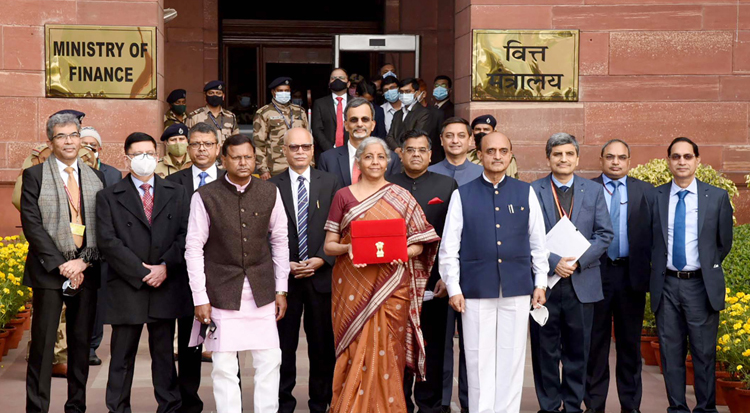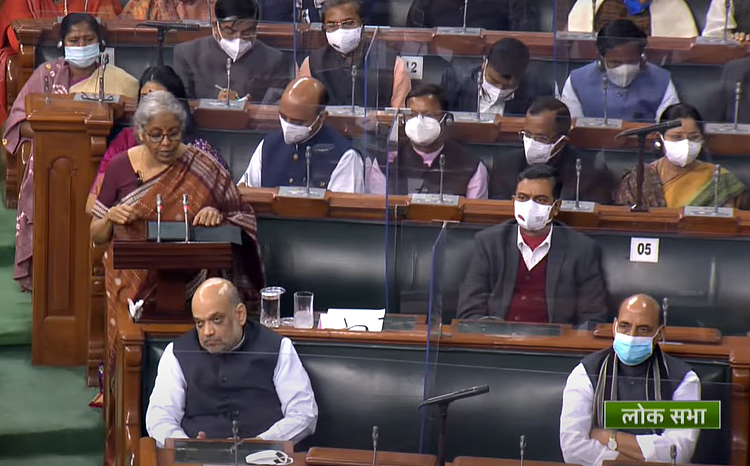INDIAN ARMED FORCES CHIEFS ON OUR RELENTLESS AND FOCUSED PUBLISHING EFFORTS

The insightful articles, inspiring narrations and analytical perspectives presented by the Editorial Team, establish an alluring connect with the reader. My compliments and best wishes to SP Guide Publications.

"Over the past 60 years, the growth of SP Guide Publications has mirrored the rising stature of Indian Navy. Its well-researched and informative magazines on Defence and Aerospace sector have served to shape an educated opinion of our military personnel, policy makers and the public alike. I wish SP's Publication team continued success, fair winds and following seas in all future endeavour!"

Since, its inception in 1964, SP Guide Publications has consistently demonstrated commitment to high-quality journalism in the aerospace and defence sectors, earning a well-deserved reputation as Asia's largest media house in this domain. I wish SP Guide Publications continued success in its pursuit of excellence.
- Operation Sindoor: Resolute yet Restrained
- India’s Operation Sindoor Sends a Clear Message to Terror and the World – ‘ZERO TOLERANCE’
- Japan and India set forth a defence cooperation consultancy framework, talks on tank and jet engines
- Terrorist Attack in Pahalgam in Kashmir: Unfolding a long surgical war against PAK
- Lt General Pratik Sharma takes over Command of Indian Army's Northern Command
Defence Budget Allocation 2022-2023
Defence Budget 2022-23 has been increased to 5.25 lakh crore for 2022-23 from the previous FY allocation of 4.78 lakh crore with a major push on ensuring self-reliance in manufacturing of military platforms
 |
The Author is Former Director General of Information Systems and A Special Forces Veteran, Indian Army |

Presenting the Union Budget 2022-23 in Parliament on February 1, 2022, Finance Minister Nirmala Sitharaman announced: 68 per cent of capital budget of the Armed Forces earmarked for domestic industry (10 per cent increase from the 58 per cent in 2021-22); Defence R&D opened up for industry, startups and academia with 25 per cent defence R&D budget; private industry will be encouraged to take up design and development of military platforms and equipment in collaboration with DRDO and other organisations through SPV model, and; an independent nodal umbrella body will be set up for meeting wide ranging testing and certification requirements.
A total of 1,52,369 crore has been set aside for capital expenditure that includes purchasing new weapons, aircraft, warships and other military hardware
Earlier on January 28, 2022, media reported that the Armed Forces have recorded an unusually slow pace of expenditure in capital budgets of FY 2021-22. The report attributed the reason to the Services having projected the revised requirement for capital budgets much higher than allocated in 2021-22. The report said that the Army, Navy and Air Force so far had spent only 40, 90 and 70 per cent respectively out of the capital outlay.
Defence Minister Rajnath Singh has asked the Services to expedite spending of capital budgets; 64 per cent earmarked in 2021-22 compared to 58 per cent during 2020-21. Overall Defence Budget 2021-22 is 4.78 lakh crore, of which the capital budget is 1.35 lakh crore. The capital outlay for the Army in the ongoing financial year was 36,000 crore, for the Navy it was 33,000 crore and for the IAF it was 58,000 crore.

Main reasons for the unusually large unexpended capital outlay of 2021-2022 are as under:
- Capping capital expenditure for domestic procurement under Atmanirbhar Bharat is good but little thought has been given whether indigenous production can or cannot meet the requirement of the forces in the required numbers and timeframe.
- DPSUs in particular did not deliver indigenous equipment in time. Delayed deliveries and contracts had a cascading effect on the payments.
- Delay in planned procurements for want of final approvals at various levels.
- An additional layer of Directorate of Military Affairs (DMA) under the CDS has been added for approvals, but capital acquisitions remains the responsibility of the Defence Secretary.
- A former Vice Chief of Army Staff while in service was told by friends in the Ministry of Defence (MoD) that Defence (Finance) is given targets every year for how much to “save” from defence budgets – hence delayed approvals putting total blame on Services.
Defence Budget 2022-23 has been increased to 5.25 lakh crore for 2022-23 from the previous FY allocation of 4.78 lakh crore with a major push on ensuring self-reliance in manufacturing of military platforms. A total of 1,52,369 crore has been set aside for capital expenditure that includes purchasing new weapons, aircraft, warships and other military hardware.
According to Defence Budget 2022-23 documents, an allocation of 2,33,000 crore has been made for revenue expenditure that includes expenses on payment of salaries and maintenance of establishments. Separately, an amount of 1,19,696 crore has been allocated for defence pensions while 20,100 crore has been set aside for the Ministry of Defence (Civil).
68 per cent of the defence capital procurement budget has been allocated towards local procurement
Defence Minister Rajnath Singh tweeted,"68% of the defence capital procurement budget has been allocated towards local procurement. It is in line with the 'Vocal for Local' push and it will certainly boost the domestic defence industries. The proposal to reserve 25% of the R&D Budget for Startups and Private entities is an excellent move.” He also said substantial amounts have been allocated towards research and development in several sectors including defence.
The 68 percent of defence capital procurement budget has been allocated towards local procurement.
— Rajnath Singh (@rajnathsingh) February 1, 2022
It is in line with the ‘Vocal for Local’ push and it will certainly boost the domestic defence industries.
Substantial amounts have been allocated towards Research and Development in several sectors including Defence.
— Rajnath Singh (@rajnathsingh) February 1, 2022
The proposal to reserve 25 percent of the R&D Budget for Startups and Private entities is an excellent move.
The defence budget is divided under four broad heads: capital outlay (for new, big-ticket acquisitions and modernisation); revenue; miscellaneous including various administrative expenses, and; defence pensions. Subdivision of the budget to the three services for FY 2022-23, especially for modernisation, has not been announced yet. However, the following issues need to be borne in mind by the policy makers and the establishment:
- The increase in defence budget is highlighted every year but its true value, positive or negative, needs to take the following into account: cost appreciation of procurements vis-ŕ-vis currency depreciation; pending payments for capital acquisitions, and percentage available for modernisation;
- Earmarking 68 per cent of capital procurements through domestic industry is a good step but must take into account indigenous production capacities lest it affects the combat capacity of the Armed Forces.
- Need to remove hurdles for spending capital outlay, both allocated and revised estimates (RE). As part of this, capital procurements must be brought under the DMA to make the system more responsive.
- Unexpended portion of defence budget must be allowed to be carried into the next FY. This has been a long standing demand of the Armed Forces.
- Opening defence R&D for industry, startups and academia with 25 per cent defence R&D budget and encouraging private industry to take up design and development of military platforms and equipment too is also a good step provided an open and level playing field is ensured – not applied only to those captive by DRDO and DPSUs or favoured private industry players. Presently the private industry cannot compete with favoured public sector.
- Shut down those DRDO labs which are not making qualitative contribution in defence research, rope in private labs and give them liberal financial support.
- Setting up of an independent nodal umbrella body for meeting wide ranging testing and certification requirements should be viewed in context of self certification by the private industry authorised in the recent past. It would be prudent to make the new body the ‘sole’ organisation for testing and certification rather than being an additional ‘nodal’ layer, closing down other organisations involved in testing and certification.
The proposal to reserve 25 per cent of the R&D Budget for Startups and Private entities is an excellent move
Finally, talking of defence of India, defence budgets and defence procurement (indigenous or otherwise) has little meaning in absence of a national security strategy. The Service Chiefs too need to speak up in this regard. Taking into account the mounting threats, the government needs to integrate the military in formulation of security strategies, for example, has the dual threat to the nation ever been discussed at the national level? It would be prudent to elevate the CDS to five-star rank and include him as permanent member of the Cabinet Committee on Security.
"Thales welcomes the forward looking statements by the Union Finance Minister that seek to strengthen the vision of Aatmanirbhar Bharat. The allocation of 68 percent of the defence procurement budget for domestic equipment in FY23 is a positive step towards self-reliance. Moreover, efforts to foster innovation by earmarking 25% of Defence R&D budget to private firms, start-ups, and academia bode well for all stakeholders and will allow international OEMs to bring more technology into India. We also appreciate the budget's emphasis on collaboration between government and industry, with private companies urged to take on the design and development of military platforms in collaboration with DRDO. These steps will enhance local capabilities and build our expertise at a world class level. We, at Thales, remain committed to strengthen our industrial footprint in India by developing our local teams, futuristic technologies and partnerships in line with the 'Make in India' initiative.”
—Ashish Saraf, VP and Country Director for Thales in India





